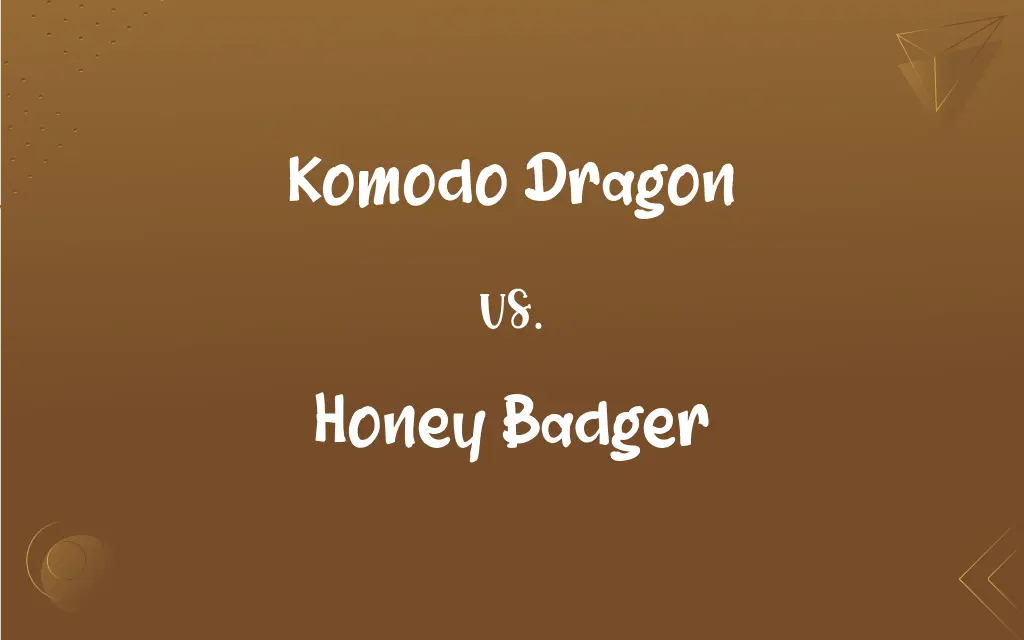Komodo Dragon vs. Honey Badger: What's the Difference?
Edited by Aimie Carlson || By Janet White || Published on October 22, 2023
The Komodo Dragon is a large monitor lizard native to Indonesia, while the Honey Badger is a small, tenacious mammal known for its fearlessness, native to Africa and Asia.

Key Differences
The Komodo Dragon, primarily found on the Indonesian islands, is the world's largest lizard and belongs to the monitor lizard family. In contrast, the Honey Badger, distributed across Africa and parts of Asia, is a fearless mammal known for its tenacity and adaptability.
While the Komodo Dragon relies on its powerful bite, often accompanied by venomous saliva, to subdue prey and scavenger on carcasses, the Honey Badger utilizes its sharp claws and strong jaws, often targeting venomous snakes and honeycombs.
The skin of the Komodo Dragon is rough, covered with osteoderms, serving as a protective layer. On the other hand, the Honey Badger boasts a tough, rubbery skin, which provides protection against predator bites and stings.
The habitat of the Komodo Dragon typically revolves around hot and dry places on the Indonesian islands, while the Honey Badger can thrive in a variety of environments, from forests and grasslands to deserts in Africa and Asia.
Both creatures are at the top of their respective food chains in their habitats. While the Komodo Dragon has fewer natural predators due to its size, the Honey Badger is often avoided by larger predators due to its aggressive nature and formidable defense mechanisms.
ADVERTISEMENT
Comparison Chart
Habitat
Indonesian islands
Africa and parts of Asia
Classification
Largest monitor lizard
Mustelid family
Diet
Carnivorous, scavenger
Omnivorous with varied diet
Skin Features
Rough skin with osteoderms
Thick, rubbery skin
Size
Up to 10 feet long
Up to 11 inches tall, 30 inches long
ADVERTISEMENT
Komodo Dragon and Honey Badger Definitions
Komodo Dragon
Native to Indonesian islands.
The Komodo Dragon is an iconic species of the Indonesian archipelago.
Honey Badger
Known for its fearlessness and tenacity.
The Honey Badger often confronts animals much larger than itself.
Komodo Dragon
World's largest monitor lizard.
The Komodo Dragon is an impressive sight due to its size and power.
Honey Badger
Has a varied diet including honey and venomous snakes.
The Honey Badger's resilience is evident when it tackles dangerous prey.
Komodo Dragon
Carnivorous predator with venomous saliva.
A bite from the Komodo Dragon can be lethal due to its venom.
Honey Badger
Native to Africa and parts of Asia.
You can encounter a Honey Badger in diverse habitats across two continents.
Komodo Dragon
Has a keen sense of smell.
The Komodo Dragon can detect carrion from miles away.
Honey Badger
Boasts a thick, protective skin.
Predators find it challenging to harm the Honey Badger due to its robust skin.
Komodo Dragon
Can live up to 30 years in the wild.
With proper conservation, a Komodo Dragon can thrive in its natural habitat for decades.
Honey Badger
Part of the mustelid family, related to weasels and otters.
Though small, the Honey Badger shares family ties with other fierce mammals.
FAQs
What does a Honey Badger primarily eat?
Honey Badgers have a varied diet, including honeycombs, insects, and even venomous snakes.
Where can you find the Komodo Dragon in the wild?
The Komodo Dragon is native to certain Indonesian islands.
Why is the Honey Badger considered so fearless?
The Honey Badger often confronts larger animals and is resistant to venom, showcasing its boldness.
Is the Honey Badger related to the badger species in North America?
While they share the name "badger," they belong to different subfamilies within the mustelid family.
Are Komodo Dragons endangered?
Yes, Komodo Dragons are classified as vulnerable due to habitat loss and other factors.
What is the primary threat to the Komodo Dragon's survival?
Habitat loss, human encroachment, and poaching are primary threats.
How does the Honey Badger defend itself?
With sharp claws, strong jaws, and a thick skin that resists bites and stings.
What regions in Africa can you find the Honey Badger?
They are widely distributed, from South Africa to Morocco and the southwestern part of Asia.
How big can a Komodo Dragon grow?
A Komodo Dragon can grow up to 10 feet in length.
Can Honey Badgers climb trees?
Yes, Honey Badgers are adept climbers and often ascend trees in search of food.
How do Komodo Dragons reproduce?
They lay eggs, which they often bury for protection.
What kind of habitats do Komodo Dragons prefer?
They prefer hot, dry areas on Indonesian islands, including savannahs and tropical forests.
How does the Honey Badger's skin protect it?
The Honey Badger's thick and rubbery skin is resistant to bites, stings, and other forms of harm.
What do young Komodo Dragons eat?
They eat insects, birds, and small mammals, gradually shifting to larger prey as they grow.
Is the Komodo Dragon venomous?
Yes, the saliva of the Komodo Dragon contains toxins that can cause blood clotting issues in its prey.
How do Komodo Dragons detect their prey?
They have an acute sense of smell and can detect carrion from miles away.
Do Honey Badgers have any natural predators?
Due to their aggressive nature and protective skin, they have few natural predators, but lions and leopards might sometimes attack them.
How fast can a Komodo Dragon run?
Komodo Dragons can reach speeds up to 13 mph in short bursts.
Are Honey Badgers solitary animals?
Yes, they are primarily solitary, except during mating seasons or when raising young.
Why is the Honey Badger associated with bravery in folklore?
Its fearless nature and willingness to confront larger animals have made it a symbol of bravery in various cultures.
About Author
Written by
Janet WhiteJanet White has been an esteemed writer and blogger for Difference Wiki. Holding a Master's degree in Science and Medical Journalism from the prestigious Boston University, she has consistently demonstrated her expertise and passion for her field. When she's not immersed in her work, Janet relishes her time exercising, delving into a good book, and cherishing moments with friends and family.
Edited by
Aimie CarlsonAimie Carlson, holding a master's degree in English literature, is a fervent English language enthusiast. She lends her writing talents to Difference Wiki, a prominent website that specializes in comparisons, offering readers insightful analyses that both captivate and inform.
































































